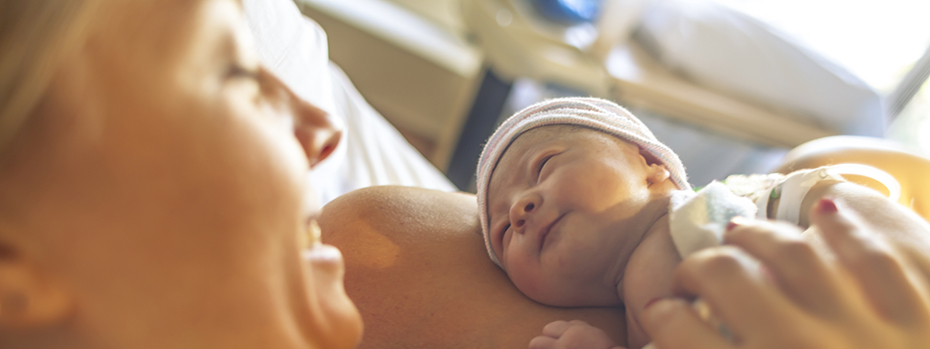VBAC (Vaginal Birth After Cesarean)

At OHSU, you’ll find support for having a vaginal birth after one or two C-sections. Our doctors and nurse-midwives are committed to using C-sections only when needed.
- Your doctor or nurse-midwife will consider your unique pregnancy and medical history to help you make the best choice for you.
- We do more VBACs than any other hospital in Oregon.
- Members of our skilled VBAC team are on-site 24/7.
- We have a high success rate. Many of our patients who try labor after a C-section have a vaginal delivery.
- If your baby needs extra care, our state-of-the-art Neonatal Intensive Care Unit (NICU) is steps away.
What is VBAC?
VBAC: Pronounced “vee-back,” it stands for vaginal birth after cesarean (C-section). It occurs when a person who has had a C-section in an earlier pregnancy gives birth through their vagina.
TOLAC: Pronounced “toe-lack.” This is a planned try to have a VBAC. It stands for trial of labor after cesarean.
Benefits of VBAC
- You avoid major surgery and don’t add more scar tissue in your abdomen and pelvis.
- You have a lower risk of bleeding, blood clots, infection, bowel and bladder damage.
- You lower your risk of problems with future pregnancies.
- You have a shorter hospital stay.
- You recover faster and resume daily life more quickly.
- You experience labor and vaginal birth, which is important to many parents.
- Your baby may have an easier time starting to breathe right after birth.
Risk of VBAC
Uterine rupture: This is when a scar from a previous C-section tears opens during labor. This serious complication occurs in less than 1% of people who try a VBAC. If it happens, you will need an emergency C-section.
Your prenatal care provider can talk to you about your risks, based on your pregnancy and delivery history.
Guidelines for VBAC
In 2017, the American College of Obstetricians and Gynecologists affirmed that:
- Trying a VBAC is safe for most people who have had one C-section.
- Trying a VBAC is safe for some people who have had two C-sections.
- People should try a VBAC only in a hospital or other place ready to perform emergency C-sections.
Personalized care
If you are thinking about VBAC, our doctors and nurse-midwives will talk with you about your current pregnancy and delivery history. If VBAC would be safe for you, we will discuss all the benefits and risks to help you make your choice.
We also know that your decision may change during pregnancy. We fully support whatever choice you make.
- How many C-sections you've had.
- Whether you’ve had previous vaginal deliveries.
- The reasons for previous C-sections.
- The type of surgical cut on your uterus in previous C-sections.
- How previous labors progressed, and whether you were induced.
- The size of your previous baby and the size of this baby.
- Your age, weight and general health.
- Your plans for future pregnancies.
- Risk factors such as preeclampsia that may arise in your current pregnancy.
You will have a C-section. At OHSU, we focus on making sure your baby’s birth is the best experience for you that it can be, no matter how you deliver.
In a nonemergency C-section you can:
- Play the music of your choice.
- Dim the lights.
- Have your partner or support person with you.
- Hold your baby skin-to-skin soon after birth.
If you need an emergency C-section, we are fully equipped to keep you and your baby safe:
- We run regular emergency simulation drills and can be ready for a C-section in minutes.
- We have doctors, anesthesiologists and nurses with deep experience in high-risk births on-site at all times.
- Even in an emergency, you can often stay awake and have your partner with you for the birth of your baby.
- We have the region’s top specialists in infant care at our advanced NICU.
Our commitment to reducing C-sections
Our commitment to offer VBAC whenever possible is part of a national effort to reduce medically unnecessary C-sections. At OHSU, we also focus on reducing first-time C-sections.
As part of this effort:
- For inductions, we use methods that increase your chance of safe vaginal delivery.
- We don’t offer elective C-sections before 39 weeks.
- As long as you and your baby are safe, we support you to continue laboring. We will not rush you or recommend a C-section unless it is medically needed.
We are proud that even though OHSU is a center for high-risk pregnancy, our C-section rates are among the lowest in the U.S.
Our NTSV (Nulliparous, Term, Singleton, Vertex) cesarean birth rate is 21%. This means that 21% of first-time (nulliparous) birth parents carrying full-term, single babies in the head-down (vertex) position give birth by C-section at OHSU. The national rate is 26%.
Learn more
- Vaginal Birth After Cesarean Delivery, American College of Obstetricians and Gynecologists
- Birth Options after Having a Cesarean, Journal of Midwifery & Women’s Health
- What is vaginal birth after cesarean (VBAC)? National Institutes of Health
For patients
- Labor and delivery: 503-494-7534
- Prenatal care: 503-418-4500
Location
Parking is free for patients and their visitors.
OHSU Hospital
3181 S.W. Sam Jackson Park Rd.
Portland, OR 97239
Driving directions
Baby Steps
A weekly guide to pregnancy and your child’s early development.
Safety resources
Get safety tips and advice from Doernbecher’s Tom Sargent Safety Center.